Response properties of neurons in primary somatosensory cortex of owl monkeys reflect widespread spatiotemporal integration
- PMID: 20164400
- PMCID: PMC2853283
- DOI: 10.1152/jn.00709.2009
Response properties of neurons in primary somatosensory cortex of owl monkeys reflect widespread spatiotemporal integration
Abstract
Receptive fields of neurons in somatosensory area 3b of monkeys are typically described as restricted to part of a single digit or palm pad. However, such neurons are likely involved in integrating stimulus information from across the hand. To evaluate this possibility, we recorded from area 3b neurons in anesthetized owl monkeys with 100-electrode arrays, stimulating two hand locations with electromechanical probes simultaneously or asynchronously. Response magnitudes and latencies of single- and multiunits varied with stimulus conditions, and multiunit responses were similar to single-unit responses. The mean peak firing rate for single neurons stimulated within the preferred location was estimated to be ∼26 spike/s. Simultaneous stimulation with a second probe outside the preferred location slightly decreased peak firing rates to ∼22 spike/s. When the nonpreferred stimulus preceded the preferred stimulus by 10-500 ms, peak firing rates were suppressed with greatest suppression when the nonpreferred stimulus preceded by 30 ms (∼7 spike/s). The mean latency for single neurons stimulated within the preferred location was ∼23 ms, and latency was little affected by simultaneous paired stimulation. However, when the nonpreferred stimulus preceded the preferred stimulus by 10 ms, latencies shortened to ∼16 ms. Response suppression occurred even when stimuli were separated by long distances (nonadjacent digits) or long times (500 ms onset asynchrony). Facilitation, though rare, occurred most often when the stimulus onsets were within 0-30 ms of each other. These findings quantify spatiotemporal interactions and support the hypothesis that area 3b is involved in widespread stimulus integration.
Figures

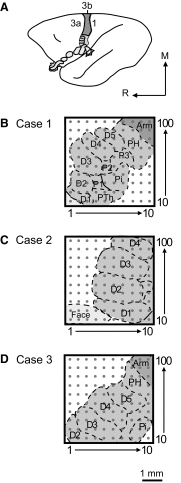
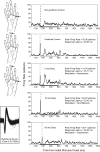
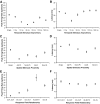

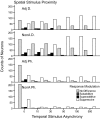
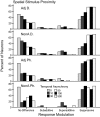
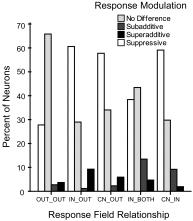
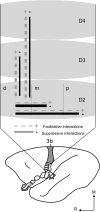
Similar articles
-
Spatiotemporal properties of neuron response suppression in owl monkey primary somatosensory cortex when stimuli are presented to both hands.J Neurosci. 2011 Mar 9;31(10):3589-601. doi: 10.1523/JNEUROSCI.4310-10.2011. J Neurosci. 2011. PMID: 21389215 Free PMC article.
-
Effects of spatiotemporal stimulus properties on spike timing correlations in owl monkey primary somatosensory cortex.J Neurophysiol. 2012 Dec;108(12):3353-69. doi: 10.1152/jn.00414.2011. Epub 2012 Sep 26. J Neurophysiol. 2012. PMID: 23019003 Free PMC article.
-
Widespread spatial integration in primary somatosensory cortex.Proc Natl Acad Sci U S A. 2008 Jul 22;105(29):10233-7. doi: 10.1073/pnas.0803800105. Epub 2008 Jul 15. Proc Natl Acad Sci U S A. 2008. PMID: 18632579 Free PMC article.
-
Modular processing in the hand representation of primate primary somatosensory cortex coexists with widespread activation.J Neurophysiol. 2010 Dec;104(6):3136-45. doi: 10.1152/jn.00566.2010. Epub 2010 Oct 6. J Neurophysiol. 2010. PMID: 20926605 Free PMC article.
-
Changes in the distributed temporal response properties of SI cortical neurons reflect improvements in performance on a temporally based tactile discrimination task.J Neurophysiol. 1992 May;67(5):1071-91. doi: 10.1152/jn.1992.67.5.1071. J Neurophysiol. 1992. PMID: 1597698
Cited by
-
Characterizing Spatiotemporal Population Receptive Fields in Human Visual Cortex with fMRI.J Neurosci. 2024 Jan 10;44(2):e0803232023. doi: 10.1523/JNEUROSCI.0803-23.2023. J Neurosci. 2024. PMID: 37963768 Free PMC article.
-
Cortical neuron response properties are related to lesion extent and behavioral recovery after sensory loss from spinal cord injury in monkeys.J Neurosci. 2014 Mar 19;34(12):4345-63. doi: 10.1523/JNEUROSCI.4954-13.2014. J Neurosci. 2014. PMID: 24647955 Free PMC article.
-
The Role of Interhemispheric Interactions in Cortical Plasticity.Front Neurosci. 2021 Jul 9;15:631328. doi: 10.3389/fnins.2021.631328. eCollection 2021. Front Neurosci. 2021. PMID: 34305511 Free PMC article.
-
Neural encoding of actual and imagined touch within human posterior parietal cortex.Elife. 2021 Mar 1;10:e61646. doi: 10.7554/eLife.61646. Elife. 2021. PMID: 33647233 Free PMC article.
-
Layer-specific activation in human primary somatosensory cortex during tactile temporal prediction error processing.Neuroimage. 2022 Mar;248:118867. doi: 10.1016/j.neuroimage.2021.118867. Epub 2021 Dec 30. Neuroimage. 2022. PMID: 34974114 Free PMC article.
References
-
- Allman J, Miezin F, McGuinness E. Stimulus specific responses from beyond the classical receptive field: neurophysiological mechanisms for local-global comparisons in visual neurons. Annu Rev Neurosci 8: 407–430, 1985. - PubMed
-
- Alvarado JC, Vaughan JW, Stanford TR, Stein BE. Multisensory versus unisensory integration: contrasting modes in the superior colliculus. J Neurophysiol 97: 3193–205, 2007. - PubMed
-
- Armstrong-James M, Fox K. Spatiotemporal convergence and divergence in the rat S1 “barrel” cortex. J Comp Neurol 236: 265–281, 1987. - PubMed
-
- Arnold PB, Li CX, Waters RS. Thalamocortical arbors extend beyond single cortical barrels: an in vivo intracellular tracing study in rat. Exp Brain Res 136: 152–168, 2001. - PubMed
-
- Berwick J, Redgrave P, Jones M, Hewson-Stoate N, Martindale J, Johnston D, Mayhew JEW. Integration of neural responses originating from different regions of the cortical somatosensory map. Brain Res 1030: 284–293, 2004. - PubMed
Publication types
MeSH terms
Grants and funding
LinkOut - more resources
Full Text Sources

